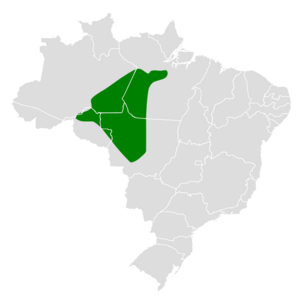Hoffmanns's woodcreeper facts for kids
Quick facts for kids Hoffmanns's woodcreeper |
|
|---|---|
 |
|
| Conservation status | |
| Scientific classification | |
| Genus: |
Dendrocolaptes
|
| Species: |
hoffmannsi
|
 |
|
Hoffmanns's woodcreeper (Dendrocolaptes hoffmannsi) is a Vulnerable species of bird in the subfamily Dendrocolaptinae of the ovenbird family Furnariidae. It is endemic to Brazil.
Contents
Taxonomy and systematics
Hoffmanns's woodcreeper is monotypic. It has in the past been treated as a subspecies of the black-banded woodcreeper (D. picumnus). Hoffmanns's, the black-banded, and the planalto woodcreeper (D. platyrostris) are very closely related, and several authors have suggested that they are conspecific.
Description
Hoffmanns's woodcreeper is one of the larger members of its subfamily. It is slim, with a long tail and a medium-length straight bill. It is 28 to 29 cm (11 to 11 in) long. Males weigh 78.5 to 86 g (2.8 to 3.0 oz) and females 74 to 89 g (2.6 to 3.1 oz). The sexes have the same plumage. Adults have a dark buffy face with a faint scaly appearance and a faint supercilium. Their forehead and crown are rufescent that becomes rufous-brown on their nape and back; their crown feathers have black tips. Their rump, wings, and tail are cinnamon-rufous to rufous-chestnut. Their throat and underparts are dull buffy with an olive cast; the latter become more ochraceous on the belly. Their breast has faint buffy streaks. Their belly and flanks have faint narrow dusky bars. Their iris is light gray to brown, their bill dusky gray to black with usually a paler mandible, and their legs and feet gray. Juveniles are similar to adults but more reddish above and more ochraceous below with variable amounts of barring and streaking on their underparts.
Distribution and habitat
Hoffmanns's woodcreeper is found in Amazonian Brazil south of the Amazon River between the Rio Madeira and Rio Tapajós. To the south it reaches Rondônia and Mato Grosso. It inhabits humid forest of both terra firme and várzea types. It favors the interior of primary forest but also occurs at its edges and in mature secondary forest.
Behavior
Movement
Hoffmanns's woodcreeper is a year-round resident throughout its range.
Feeding
The diet of Hoffmanns's woodcreeper had not been documented but is assumed to be mostly arthropods. It often follows army ant swarms and is thought to also join mixed-species feeding flocks. It mostly forages singly. When following ant swarms it perches on vertical trunks within 2 m (7 ft) of the ground and sallies from there to pick prey from vegetation. Away from ant swarms it forages as high as the subcanopy.
Breeding
Hoffmanns's woodcreeper appears to breed in the late dry and early wet seasons of September to November. One nest was in a cavity in a dead tree trunk about 18 m (60 ft) above the ground. Nothing else is known about the species' breeding biology.
Vocalization
Hoffmanns's woodcreeper mostly sings at dawn, though probably at dusk as well. Its song is a "level, rapid 'wutwutwut---' " with up to about 20 iterations. Its calls include " 'wh’kai', 'kaihh-jeep' and snarling."
Status
The IUCN originally assessed Hoffmanns's woodcreeper as being of Least Concern but since 2012 has classed it as Vulnerable. "The primary threat to this species is accelerating deforestation within its restricted range in the Amazon basin. It is thought to be highly sensitive to human disturbance, and its natural rarity and preference for primary forest are likely to make it particularly susceptible to threats." It "occurs in a region that is ornithologically poorly known" and is "rarely seen and little-known".


